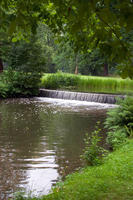You are in: Europe -> Germany -> Muskauer Park / Park... , and traditional search or Image Gallery will yield results of this site only
Muskauer Park / Park Muzakowski
| Site number: | 1127 |
|
| Type of site: | Cultural | |
| Date: | 1815 - 1844 | |
| Date of Inscription: | 2004 | |
| Location: | Europe, Germany and Poland, State of Saxony (Sachsen) (DE) / Lubusz Voivodship (PL) | |
Up to 75 images are shown here. Click on each for more details or on Image Gallery for more images.
| Description: | The landscaped Muskauer Park stretches 559.90-ha straddling the Neisse River along the Polish and German border, it was fashioned by Prince Hermann von Puckler-Muskau in 1815-1844. The park, seamlessly merging with its neighboring farm-landscape, established innovative methods of landscape design; its influence touched the development of landscape architecture around Europe and America. It did not seek to represent classical landscapes, paradise, or some lost perfection, the park was designed as a ‘painting with plants’, as it chose to enhance the intrinsic qualities of the existing landscape by utilizing local plants. This integrated landscape reaches into the town of Muskau, its green passages shaping urban parks that encased the areas for development; the town thus developed into a design constituent within a utopian landscape. The site also boasts a renovated castle, bridges and an arboretum. --WHMNet paraphrase from the description at WHC Site, where additional information is available. | |
| The Muskauer Park (German common: Muskauer Park, officially: Fürst-Pückler-Park, Polish: Park Mużakowski), is the biggest and one of the most famous English-style parks of Germany and Poland. It covers 3.5 square kilometres of land in Poland and 2.1 in Germany. The park extends on both sides of the Lusatian Neisse river, which constitutes the border between the countries. The 17.9 square kilometres buffer zone around the park encompassed the German town Bad Muskau in the West and Polish Łęknica in the East. The heart of the park are the partially wooded raised areas on the east bank of the river called The Park on Terraces. On July 2, 2004, the UNESCO inscribed the park on the World Heritage List, as an exemplary example of cross-border cultural collaboration between Poland and Germany. It was inscribed to the list on two criteria, for breaking new ground in terms of development towards the ideal man-made landscape, and its influence on the development of landscape architecture as a discipline. The founder of the park was Prince Hermann von Pückler-Muskau (1785-1871), the author of the influential Hints on Landscape Gardening and the owner of Bad Muskau since 1811. After prolonged studies in England, in 1815 he founded the Park. As time went by, he established an international school of landscape management in Bad Muskau and outlined the construction of an extensive landscape park which would envelop the town "in a way not done before on such a grand scale". The works involved remodelling the Old Castle and construction of a Gothic chapel, an English cottage, several bridges, and an orangery. Pückler reconstructed the New Castle as the compositional centre of the park, with a network of paths radiating from it. This went on until 1845, when Pückler was constrained to sell the patrimony. Soon it was bought by a Dutch prince, who employed Eduard Petzold, Pückler's disciple and a well-known landscape gardener, to complete his design. --Wikipedia. Text is available under the Creative Commons Attribution-ShareAlike License. | ||
| Source: | http://whc.unesco.org/en/list/1127 | |
| Reference: | 1. UNESCO World Heritage Center, Site Page. | |




















